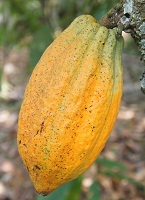THE EIGHT NEW COCOA HYBRIDS

Cocoa was introduced by the Portuguese into the Gulf of Guinea from where it got to Nigeria around the last quarter of the nineteenth century. The introduced variety was the Amelonado. This variety later became unique to West Africa, hence the name “ West African Amelonado“, for it’s significant chocolate chocolate flavor which remains a benchmark in the World Cocoa industry till date. The genotype is genetically uniform and was susceptible to swollen shoot and phytophthora pot rot diseases, mirids and drought. Swollen shoot disease especially almost destroyed the West Africa cocoa industries in the 1930s and 1940s. As a means of rescue, a population of open pollinated synthetic F3 Amazon produced through selection from the population of the Upper Amazon Foresteros and Trinitario were developed. The distribution of this variety to farmers in Nigeria became operational from 1954 to date. Cocoa production received a boost through F3 Amazon; years to reaching maturity declined from 5-7 years (Amelonado variety) to 3-4 years, tree vigour and drought tolerance improved, pod bearing changed from one peak to two (main and light) etc. However, the cocoa quality profile of the West African cocoa drastically dropped.
For West Africa to re-position herself for high cocoa quality, further breeding research at the West Africa Cocoa Research Institute (WACRI), Tafo, Ghana, through selection led to the selection of WACRI series I and II which was released to the farmers in the 1960s and early 1970s. These varieties are still in farmer’s field in Nigeria and some other West African countries.
Cocoa Research Institute of Nigeria (CRIN) became autonomous in the early 1960s and in continuation of earlier role while existing as the Nigerian substation of WACRI has engaged in cocoa breeding to fulfill her mandate to develop improved cocoa planting material in Nigeria. In 1972, the second national cocoa breeding programme through selection resulted in “ Establishment Ability Elites“. These varieties in addition to better yield , were adaptable to marginal and drought prone areas. That seems to be the last impactful efforts on cocoa breeding in Nigeria before the inception of a Global Cocoa Breeding Initiative i.e. CFC/ICCO/IPGRI project. Many other breeding attempts before this project were unsuccessful.
The current yield obtainable in the farmers field is around 450-520kg/ha. Therefore, the development of high yielding and pest and disease resistance cocoa varieties is very imperative. The ten years CFC/ICCO/IPGRI project was in two phases. The main objective of the project was to develop new cocoa varieties that will be: high yielding, early bearing, resistant to phytophthora pod rot, resistant to mirids, and also have good and acceptable physical and chocolate flavor quality. To generate hybrids to meet the above goals, parental stocks were selected, crosses were made. The generated progenies we evaluated on-station at CRIN and in twelve on-farm sites in Nigeria.
The on-station and on-farm evaluation resulted in the selection of twelve cocoa hybrids which was presented for release to the National Crop and Livestock Varieties registration and Release Committee in November, 2010. Eight of the twelve hybrids were accepted and therefore officially released in December, 2010 by the committee. Their official nomenclatures are: CRIN TC-1, CRIN TC-2, CRIN TC-3, CRIN TC-4, CRIN TC-5, CRIN TC-6, CRIN TC-7 and CRIN TC-8. Generally , these 8 hybrids have diverse genetic base; they are early bearing, high yielding with very low input, resistant to major pests and diseases of cocoa, highly adaptable to cocoa ecologies of Nigeria, very good cocoa quality traits etc.
The low input for high productivity of these materials will greatly encourage enhanced cultivation of cocoa, making the venture more profitable and attractive for those involved, also encouraging others to tap into it. This together will put the nation on the track of meeting the global quest for organic cocoa products.
























